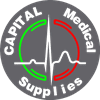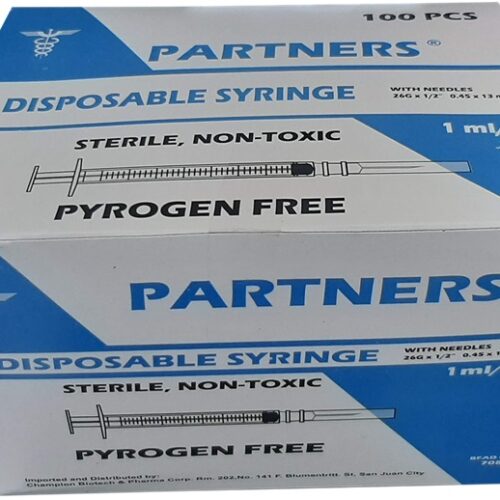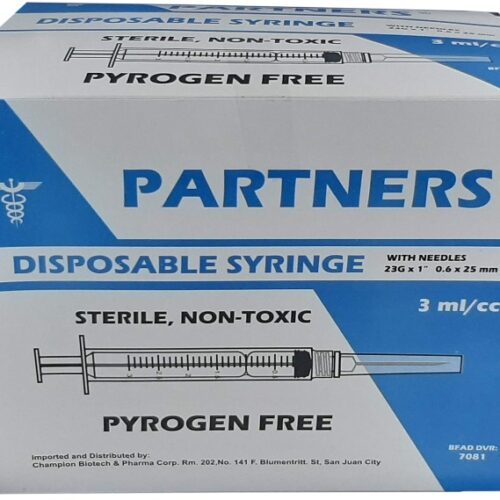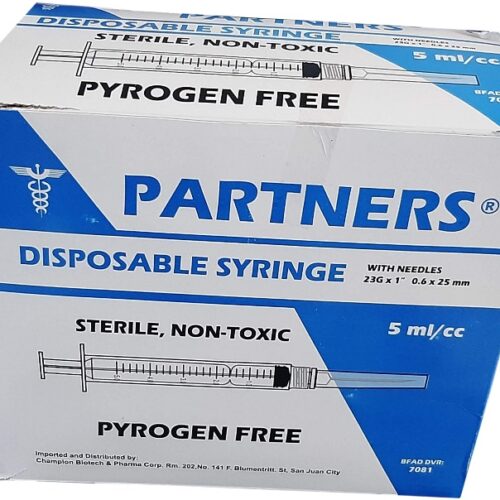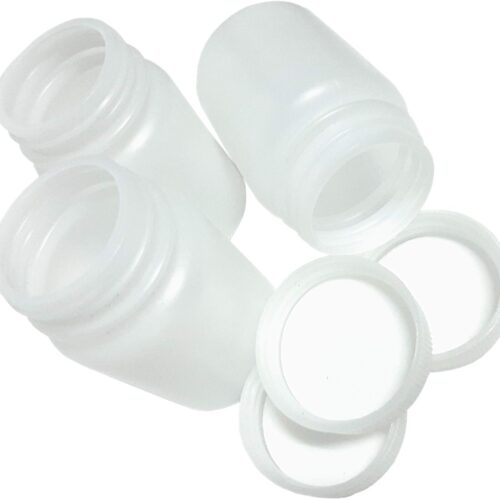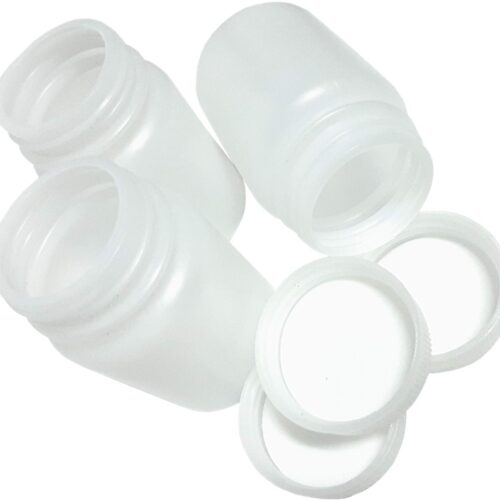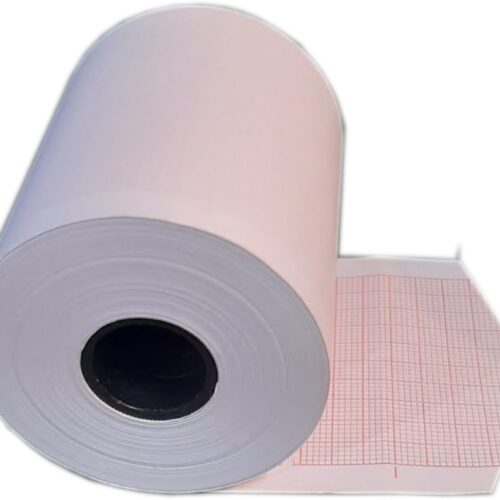Showing 81–96 of 444 results
-
Disposable Syringe w/ needle 5 cc/mL
0₱315.00>Primaplus
> Disposable Syringe
> 5cc/ml
> Non-Toxic
> Non-Pyrogenic
> Do not use if pack is openA syringe is a simple reciprocating pump consisting of a plunger that fits tightly within a cylindrical tube called a barrel. The plunger can be linearly pulled and pushed along the inside of the tube, allowing the syringe to take in and expel liquid or gas through a discharge orifice at the front end of the tube. The open end of the syringe may be fitted with a hypodermic needle, a nozzle or tubing to direct the flow into and out of the barrel. Syringes are frequently used in clinical medicine to administer injections, infuse intravenous therapy into the bloodstream, apply compounds such as glue or lubricant, and draw/measure liquids.
-
Disposable Syringe With Needle Luer Lock 1 cc/mL, 26G x 1/2
0₱305.00> Partners
> Disposable Syringe with needle
> Sterile non-toxic
> 1cc
> 26g x 1/2”
> 0.45 x 13mm
> 100pcs -
Disposable Syringe With Needle Luer Lock 3 cc/mL, 23G x 1
0₱284.00> Sure-Guard
> Disposable Syringe
> With Needle Slip Tip
> Single Use Only
> Non-Toxic
> Non-Pyrogenic
> Sterile
> 3cc 23gx1″ (0.6x25mm)
> 100 pcs -
Disposable Syringe With Needle Luer Lock 3 cc/mL, 23G x 1
0₱310.00?> Partners
?> Disposable Syringe With Needles
?> 23g x 1inch
?> 0.6 x 25mm
?> Sterile Non-Toxic
?> 3ml/cc
?> 100 pcs
A syringe is a simple reciprocating pump consisting of a plunger that fits tightly within a cylindrical tube called a barrel. The plunger can be linearly pulled and pushed along the inside of the tube, allowing the syringe to take in and expel liquid or gas through a discharge orifice at the front end of the tube. The open end of the syringe may be fitted with a hypodermic needle, a nozzle or tubing to direct the flow into and out of the barrel. Syringes are frequently used in clinical medicine to administer injections, infuse intravenous therapy into the bloodstream, apply compounds such as glue or lubricant, and draw/measure liquids. -
Disposable Syringe With Needle Luer Lock 5 cc/mL, 23G x 1
0₱326.00?> Partners
?> Disposable Syringe With Needles
?> 23g x 1inch
?> 0.6 x 25mm
?> Sterile Non-Toxic
?> 5ml/cc
?> 100 pcs
A syringe is a simple reciprocating pump consisting of a plunger that fits tightly within a cylindrical tube called a barrel. The plunger can be linearly pulled and pushed along the inside of the tube, allowing the syringe to take in and expel liquid or gas through a discharge orifice at the front end of the tube. The open end of the syringe may be fitted with a hypodermic needle, a nozzle or tubing to direct the flow into and out of the barrel. Syringes are frequently used in clinical medicine to administer injections, infuse intravenous therapy into the bloodstream, apply compounds such as glue or lubricant, and draw/measure liquids. -
Disposable Syringe With Needle Slip Tip 1 cc/mL, 25G 5/8 (0.5 x 16mm)
0₱294.00> Sure-Guard
> Disposable Syringe
> With Needle Slip Tip
> Single Use Only
> Non-Toxic
> Non-Pyrogenic
> Sterile
> 1cc 25gx5/8 (0.6 x 16 mm)
> 100 pcs -
Disposable Syringe, With Needle Luer Lock 5 cc/mL, 23G x 1″
0₱394.00> Sure-Guard
> Disposable Syringe
> With Needle Luer Lock
> Single use only
> Non-Toxic
> Non- Pyrogenic
> Sterile
> 5cc 23g x 1″ (0.6 x 25mm)
> 100pcs -
Drug Testing Bottle, Urine Cups, Screwcap Non-Sterile, 60mL, White Plastic, 100pcs
0₱924.00> Drug Testing
> Bottle
> Urine Cups
> Color White
> 60 ml
> Screwcap
> Plastic
> 100 pcs
> Non-SterileA drug test is a technical analysis of a biological specimen, for example urine, hair, blood, breath, sweat, and/or oral fluid/saliva?to determine the presence or absence of specified parent drugs or their metabolites. Major applications of drug testing include detection of the presence of performance enhancing steroids in sport, employers and parole/probation officers screening for drugs prohibited by law and police officers testing for the presence and concentration of alcohol in the blood commonly referred to as BAC. BAC tests are typically administered via a breathalyzer while urinalysis is used for the vast majority of drug testing in sports and the workplace. Numerous other methods with varying degrees of accuracy, sensitivity, and detection periods exist.
-
Drug Testing Bottle, Urine Cups, Screwcap Non-Sterile, 60mL, White Plastic, 10pcs
0₱102.00> Drug Testing
> Bottle
> Urine Cups
> Color White
> 60 ml
> Screwcap
> Plastic
> 10 pcs
> Non-SterileA drug test is a technical analysis of a biological specimen, for example urine, hair, blood, breath, sweat, and/or oral fluid/saliva?to determine the presence or absence of specified parent drugs or their metabolites. Major applications of drug testing include detection of the presence of performance enhancing steroids in sport, employers and parole/probation officers screening for drugs prohibited by law and police officers testing for the presence and concentration of alcohol in the blood commonly referred to as BAC. BAC tests are typically administered via a breathalyzer while urinalysis is used for the vast majority of drug testing in sports and the workplace. Numerous other methods with varying degrees of accuracy, sensitivity, and detection periods exist.
-
Drug Testing Bottle, Urine Cups, Screwcap Non-Sterile, 60mL, White Plastic, 500pcs
0₱4,200.00> Drug Testing
> Bottle
> Urine Cups
> Color White
> 60 ml
> Screwcap
> Plastic
> 500 pcs
> Non-SterileA drug test is a technical analysis of a biological specimen, for example urine, hair, blood, breath, sweat, and/or oral fluid/saliva?to determine the presence or absence of specified parent drugs or their metabolites. Major applications of drug testing include detection of the presence of performance enhancing steroids in sport, employers and parole/probation officers screening for drugs prohibited by law and police officers testing for the presence and concentration of alcohol in the blood commonly referred to as BAC. BAC tests are typically administered via a breathalyzer while urinalysis is used for the vast majority of drug testing in sports and the workplace. Numerous other methods with varying degrees of accuracy, sensitivity, and detection periods exist.
-
ECG Electrodes Adult
0₱410.00> Ecg Electrodes
> Ag/AgCI Sensor
> Solid Gel
> 30d max
> Adult
> 50pcs/pck
> Single useAn electrocardiogram (ECG) is one of the simplest and fastest tests used to evaluate the heart. Electrodes (small, plastic patches that stick to the skin) are placed at certain spots on the chest, arms, and legs. The electrodes are connected to an ECG machine by lead wires.
-
ECG Electrodes Pedia
0₱819.00> Ecg Electrodes
> Ag/AgCI Sensor
> Solid Gel
> 30d max
> Infant
> 100pcs/pck
> Single useAn electrocardiogram (ECG) is one of the simplest and fastest tests used to evaluate the heart. Electrodes (small, plastic patches that stick to the skin) are placed at certain spots on the chest, arms, and legs. The electrodes are connected to an ECG machine by lead wires.
-
ECG Thermal Paper 50mm x 30mm
0₱58.00> Partners
> ECG Paper
> Per Roll
> Use to Measure the Electrical Activity Conduction of the Heart
> Size
> 50mm x 30mm 1RollThe Ecg Paper The electrocardiogram (ECG or EKG) is used to measure the electrical activity and conduction of the heart. When electrical depolarization of the heart muscles occur, the cardiac muscles contract. This electrical depolarization (electrical activity) is amplified and recorded for analysis.
-
ECG Thermal Paper 50mm x 30mm
0₱58.00> WINGUARD
> ECG Paper
> Per Roll
> Use to Measure the Electrical Activity Conduction of the Heart
> Size
> 50mm x 30mm 10RollsThe Ecg Paper The electrocardiogram (ECG or EKG) is used to measure the electrical activity and conduction of the heart. When electrical depolarization of the heart muscles occur, the cardiac muscles contract. This electrical depolarization (electrical activity) is amplified and recorded for analysis.
